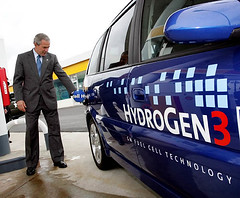Unsustainable asphalt nation
 President Bush at the Shell Hydrogen demonstration gas station on Benning Road in the northeast quadrant of Washington, DC. Expect to see a significant impact from hydrogen power in about 2060...
President Bush at the Shell Hydrogen demonstration gas station on Benning Road in the northeast quadrant of Washington, DC. Expect to see a significant impact from hydrogen power in about 2060...In "A crude awakening: It's a long highway to automotive sanity" the Boston Globe's Sam Allis discusses the energy-automobile future:
"The experience at the pump is so horrid these days that I hightailed it over to MIT last week to talk to the Yoda of the automobile engine, John Heywood, the director since 1972 of the Sloan Automotive Laboratory there and codirector of the Ford-MIT Alliance. You want to talk about car engines, he's the guy...
Doom-and-gloom types love to be right, so I'm delighted to report that Heywood is, for now, in my corner. ''The pessimists are telling a more convincing story than the optimists at the moment," he says. For one thing, the huge energy appetites of China and India are here to stay. For another, he adds, ''There's a rising sense that world production will peak in the next decade or so."
Add this news to a figure that will take your breath away: 1 percent of the gas in your car is used to carry you. (By ''you," Heywood means an average payload of two people and a couple of bags.) A mere 10 percent of the gas powers the vehicle itself. The rest is dissipated in the engine, transmission, accessories like air conditioning, and endless idling. It gets worse. Engine efficiency has improved 30 percent over the past 25 years, but all of it has been lost to our thirst for heavier, higher-performance cars. So it's a wash. We've gone nowhere.
If we're going to improve fuel efficiency, we should start with a Hummer rather than a small sedan simply because the Hummer uses so much more gas than the peewee. ''We've got to focus on the big, heavy end of the spectrum," says Heywood. But it is precisely that end of the market -- the sport utility vehicles and light trucks -- that has kept the domestic auto industry afloat.
According to a ton of market research, Americans are unwilling to pay much for better fuel efficiency, yet they'll pay through the nose for more power. ''This tells us the broader public hasn't been that concerned with the cost of refilling their vehicles," he says. Yes, the sales of the giant SUVs are off, but America has not yet changed psychological gears over the cost of driving.
''The very important question we don't have the answer to," says Heywood, ''is whether you think the future will be about the same as the past or significantly different."
Most sobering are the timelines needed to bring four new engine technologies to use in sufficient numbers to affect domestic gas consumption.
To have such impact, Heywood estimates, these projections demand improvements in a third of the cars sold in the United States that will translate, in turn, to a third of the total miles driven.
With that in mind, a better gasoline engine of the future is about 20 years away from reaching the point where it will do significant good, according to his numbers.
An improved diesel will take 30 years. We're talking 35 years for a gasoline hybrid and a breathtaking 55 years for a hydrogen fuel cell hybrid pushed by George Bush." ...



0 Comments:
Post a Comment
<< Home